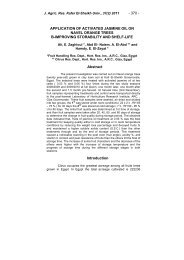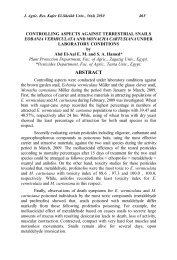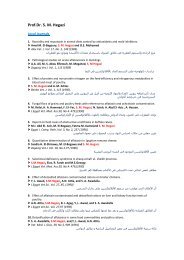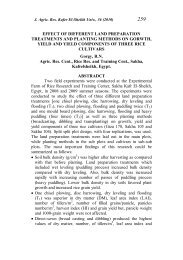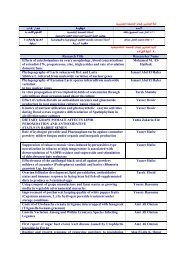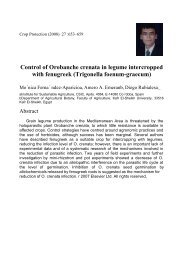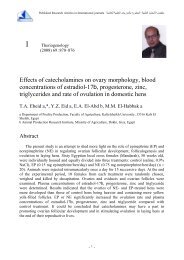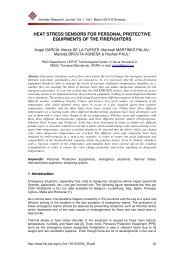DOUBLE-LAYER KNITTED FABRICS FOR ARMS PROTECTION
DOUBLE-LAYER KNITTED FABRICS FOR ARMS PROTECTION
DOUBLE-LAYER KNITTED FABRICS FOR ARMS PROTECTION
Create successful ePaper yourself
Turn your PDF publications into a flip-book with our unique Google optimized e-Paper software.
Smartex Research Journal, Vol. 1, No1, March 2012 © Smartex.<br />
<strong>DOUBLE</strong>-<strong>LAYER</strong> <strong>KNITTED</strong> <strong>FABRICS</strong> <strong>FOR</strong> <strong>ARMS</strong><br />
<strong>PROTECTION</strong><br />
Ana- Ramona CIOBANU 1 & Mirela BLAGA 2<br />
Ph. D Student 1 , Assoc. Prof. 2 , Department of Knitting and Ready-made Clothing<br />
Faculty of Textiles, Leather and Industrial Management<br />
‘Gheorghe Asachi’ Technical University, Iasi, Romania<br />
E-mail : mirela_blaga@yahoo.com<br />
Abstract: Hand protection varies from industry to industry and they came in various products<br />
like gloves, arms and forearms, protective sleeves, made from diferent materials designed to<br />
ensure the best protection against the specific hazard. The paper presents a method of<br />
producing an arm protection product by using flat knitting technology. The protective article is<br />
designed to protect the forearm and it is designed to fit various hand circumference by using a<br />
velcro closing system. The knitted product covers the forearm to the middle of the palm area,<br />
with a shaped knitted hole in the thumb finger position. By using the technical capabilities of<br />
the electronic V-bed flat knitting machines and the principles of knitting double face fabrics,<br />
the protective article is a double-layer one. Each layer might integrate different raw materials<br />
and by exploiting the one-step knitting process, various combinations become possible. The<br />
paper presents the technical solution to make such types of double layered forearm protective<br />
articles, manufactured on the computer controlled CMS 530 Multigauge, E 12, Stoll flat<br />
knitting machine.<br />
Key words: double-layer knitted fabric, arm protection article, V-bed flat knitting machines.<br />
1. Introduction<br />
Protection of the body during daily activities is one of the main important concern and<br />
objectives of humans. From a domain to another, articles designed to protect the superior<br />
members of the human body, take various forms, from glove for the hands to protective<br />
sleeve that covers the entire arm, or just parts of the arm.<br />
The forearm articles exist in a large variety, that why it must be taken into consideration the<br />
suitability of one product to the specific end use. No matter of the concrete use, like:<br />
protection, medical, sports, etc, a good protective sleeve must fit well, by following as much<br />
as possible, the contour of the arm. Also, it must provide the desired protection, while is being<br />
lightweight enough, not to restrict the mobility of the superior members.<br />
Protective sleeves made from multilayer compression blocks and impact pads used in the<br />
sports field, are designed in such way, that can ensure the proper protection but also to not<br />
restrict the movements [1]. For the aerobic workout some forearm sleeves can have weights<br />
included, in order to add resistance. A certain compression, insulation and antibacterial<br />
protection must be ensured by the arm sleeves used in surgery recovery from injury [2].<br />
In the pressure therapy, extra pressure can be applied to the muscles from the forearm, by<br />
including some tension straps in the sleeves and also it can be used a dual tension straps,<br />
which distribute the pressure over a larger area [3].<br />
For the mechanical purpose, the sleeves can be made from Kevlar to ensure protection<br />
against cuts, puncture and shear resistance, or it can have a metallic shield used by the<br />
mechanics, to protect from the engine manifold or other heated objects [4].<br />
Insulation from wind can be ensured by ussing a sleeve with a glove wich has an elastic wrist<br />
ribon [5]. Other sleeves consist of outer layer made from a water repelant, ensuring protection<br />
against some liquids [6]. Regardless to the field of application, these type of articles are made<br />
from various materials suited to its intended use.<br />
http://www.kfs.edu.eg/srj /No1-2012/0111_116.pdf<br />
111
Smartex Research Journal, Vol. 1, No1, March 2012 © Smartex.<br />
One can conclude that it is increasingly felt that there is a need for engineering of<br />
protective knitted materials for diverse applications, where functional properties have<br />
preponderance over the aesthetics.<br />
2. Materials and method<br />
All the protective forearms products, exhibit diferent shape that covers the forearm until the<br />
wrist and some article can be extended to the level of the finger linqing or to the fingertips as<br />
an included glove. Combination of layers made from the same type of materials or materials<br />
with different properties can increase the end use properties of these arm sleeves.<br />
The process of producing this type of sleves usualy implies cutting the materials and<br />
assembling all parts together by employing the sewing procces.<br />
Using the technical capabilities of the electronic V-bed flat knitting machines and the<br />
principles of knitting double face fabrics, the arm sleeves with a double-layer material can be<br />
produced by exploiting the single knitting stage.<br />
This type of knitting machines equipped with at least two needle beds, have the ability to<br />
create independent layers of fabric, which are either separate or held together by loops or<br />
tucks, or by other knitted layers (Figure 1). The principle of creating a multilayer knitted fabric<br />
consist in knitting two main layers in vertical position, usually in a one step knitting process.<br />
The total number of layers that can be knitted is limited by the number of the knitting needles,<br />
specially the distance between the active needles.<br />
a b c<br />
Figure1: Double layer knitted fabrics: a. Layers conectted by loops; b. Layers conectted by tucks; c. Layers<br />
conecteded by the third knitted layer [7]<br />
The main advantage of this knitting process consists in creating fabrics with unique structures<br />
by connecting together two layers made from materials with different properties. The weight,<br />
aesthetic properties and costs can be controlled, to create the proper fabric for fulfilling the<br />
requirements of the end product.<br />
The sandwich structures offer huge potential of diversification, by applying different solutions<br />
[7]:<br />
� Varying the number of layers;<br />
� Engineering the fabric thickness;<br />
� Developing different structure and opacity independently on both faces;<br />
� Filling the space between the two outer fabrics, with materials;<br />
� Designing the cross section geometry.<br />
The paper presents a technical solution for manufacturing a double layer forearm weft knitted<br />
product, on the computer controlled CMS 530 Multigauge, E 12, Stoll flat knitting machine.<br />
The knitted fabric is designed to protect the forearm and to fit various hand circumferences,<br />
by using a velcro closing system (Figure 2a). The knitted product covers the forearm down<br />
from the elbow to the middle of the palm area, with a shaped knitted hole in the thumb finger<br />
position (Figure 2b).<br />
http://www.kfs.edu.eg/srj /No1-2012/0111_116.pdf<br />
112
Smartex Research Journal, Vol. 1, No1, March 2012 © Smartex.<br />
a. b.<br />
Figure 2: Forearm sleeve product: a. Components of the knitted forearm sleeve; b. Final product<br />
The knitting process of the double-layer forearm sleeve starts by knitting first the border that<br />
surrounds the arm down of the elbow. To ensure a good position of the product on the hand,<br />
an elastic rib 2x2 structure is used for the border, under the elbow, preventing thus the fabric<br />
rolling down during its wearing (Figure 3).<br />
a b<br />
Figure 3: The knitted forearm sleeve: a. Double layer knitted forearm fabric; b. Final product.<br />
After the border ends, the knitting is continuing with body of the sleeve, until the thumb<br />
position.<br />
The sleeve article is a double-layer fabric, produced in a one-step knitting process, each layer<br />
integrating different types of raw materials, which means different type of yarns (Figure 4a, b).<br />
For this purpose, the knitting machine must be equipped with at least two yarn feeders, each<br />
yarn feeder for each knitted layer and for the thumb area four yarn feeders.<br />
a. b.<br />
Figure 4: Forearm knitted sleeve: a. Theoretical representation of the two layers; b. Symbol view of the knitted<br />
structures.<br />
http://www.kfs.edu.eg/srj /No1-2012/0111_116.pdf<br />
113
Smartex Research Journal, Vol. 1, No1, March 2012 © Smartex.<br />
The two individual layers are held together by the interlock knitted structure, located on the<br />
product lateral edges.<br />
The closing system of the forearm sleeve uses Velcro strips, with the purpose of a better<br />
adjustment for different arm circumferences. The area where the velcro strips are attached on<br />
the product, must be resistant and not very extensible, to enable them to be sewn. For this<br />
purpose, interlock structure gives stability to the fabric, in the area of velcro stripes<br />
attachments (Figure 4b).<br />
The thumb finger’s area is a shaped hole, which is going to be fashioned by successive<br />
narrowing of the both knitted layers and successive widening (Figure 5).<br />
The fashioned thumb orifice contour can be performed on the knitting machines that are<br />
equipped with two needle beds having the possibility that at least one of the two needle bed is<br />
mobile, in order to facilitate the stitches transfer.<br />
Figure 5: Fashioned thumb hole contour using successive narrowing - Symbol view.<br />
http://www.kfs.edu.eg/srj /No1-2012/0111_116.pdf<br />
114
Smartex Research Journal, Vol. 1, No1, March 2012 © Smartex.<br />
To fashion the thumb aperture shape, in the knitting process are used four yarn feeders, two<br />
for the right side of the thumb hole area and two for the left side. Each yarn feeder is used to<br />
knit the two individual layers for the both side of the hole.<br />
The final step represents the palm area of the forearm sleeve. From the thumb area to the<br />
middle of the hand’s palm area, the article is knitted in the same way, like the body part of the<br />
product.<br />
To prevent the ravelling of the edge where the knitted processes of the sleeve ends, a sewing<br />
solution can be use to cover it up.<br />
3. Discussions<br />
The main advantage of producing a double – layer protective sleeve on the computer<br />
controlled flat knitting machines is the low manufacturing time, which in this case is 4 minutes<br />
for all knitting process (Figure 6).<br />
Figure 6: The estimated knitting time for producing the knitted sleeve.<br />
The second positive feature is the manufacturing operations, consisting only of some sewing<br />
operations for velcro attachments and to finish the end of the product.<br />
The use of different raw materials on the both sides of the product does not imply the<br />
increasing of the knitting time, it represents just another possibility of developing various<br />
combinations of controlled properties on both product sides.<br />
In case of employing different raw materials on the individual layers, the knitting machine<br />
must have more than one yarn feeder to produce the layers in a one-step process. The<br />
number of the yarns feeders must be equal with the number of the layers. The number of<br />
layers cannot exceed the maximum number of the yarn feeders from the machine.<br />
Another technical requirement concerning the knitting machine with two needle beds, is the<br />
capability of one needle bed to perform racking movement, in order to adapt the right relative<br />
needles position for loops transfer. The transfer capabilities of the electronic knitting machines<br />
are also used to create the opening for the thumb finger, by successive narrowing followed by<br />
successive widening.<br />
4. Conclusions<br />
The proposed forearm protective knitted product has been created on the principle of double<br />
face knitting, increasing thus the properties of the end use of the fabric, by varying the two<br />
faces properties.<br />
The outer layer can be made from a high performance yarn that offers a special protection<br />
(cut-resistant, puncture-resistant or thermal-resistant) and the inner layer from yarns like<br />
cotton or bamboo, designated to absorb the moisture, increasing the comfort of the wearer.<br />
Another possibility is to fill the space between the two layers with protective pads, resistant to<br />
impacts; creating so a protective article for hard sport activities.<br />
The same fabric can be turned into a medical product, by using yarns with antimicrobial<br />
properties in the inner layer and the outer layer only to protect this one.<br />
The single step knitting process of a double-layer fabric can be used to produce products with<br />
different type of materials in a short time. Considering this and the low number of<br />
manufacturing operations for the final article, the costs of the fabrication can be easily<br />
reduced.<br />
http://www.kfs.edu.eg/srj /No1-2012/0111_116.pdf<br />
115
References<br />
Smartex Research Journal, Vol. 1, No1, March 2012 © Smartex.<br />
[1] Sports Medicine> Hand/Arm/Wrist/Elbow- McDavid ® , Available from<br />
http://www.mcdavidusa.com/store/item.asp?ITEM_ID=400&DEPARTMENT_ID=198,<br />
Accessed: 2011-09-30.<br />
[2] Healing Enhancements-Arm Compression Sleeves, Available from<br />
http://www.healingenhancements.com/armcompressionsleeves.aspx, Accessed: 2011-09-<br />
30.<br />
[3] Hammacher Schlemmer-The Muscle Recovery Compression Sleeves, Available from<br />
http://www.hammacher.com/Product/78524, Accessed: 2011-09-30.<br />
[4] Grady N. Elliot, Arm protector, Patent No.: US: 4.967.419., United State Patent<br />
Application Publication, Publication date: Nov. 6, 1990.<br />
[5] Marion Dianne Holmes, Arm protective knitted articles of clothing, Patent No.: US: 2009/<br />
0100561 A1, United State Patent Application Publication, Publication date: Apr. 23, 2009.<br />
[6] Anastasia Fragomell, Protective sleeve, Patent No.: US: 5.924.130., United State Patent<br />
Application Publication, Publication date: Jul. 20, 1999.<br />
[7] M. Penciuc, M. Blaga, C.D. Radu, Manufacturing of 3d complex knitted shapes, Book of<br />
proceedings, 45th International Congress IFKT, pp. 1000-1005, ISBN 978-961-6045-79-7<br />
(oral presentation), 2010.<br />
http://www.kfs.edu.eg/srj /No1-2012/0111_116.pdf<br />
116



